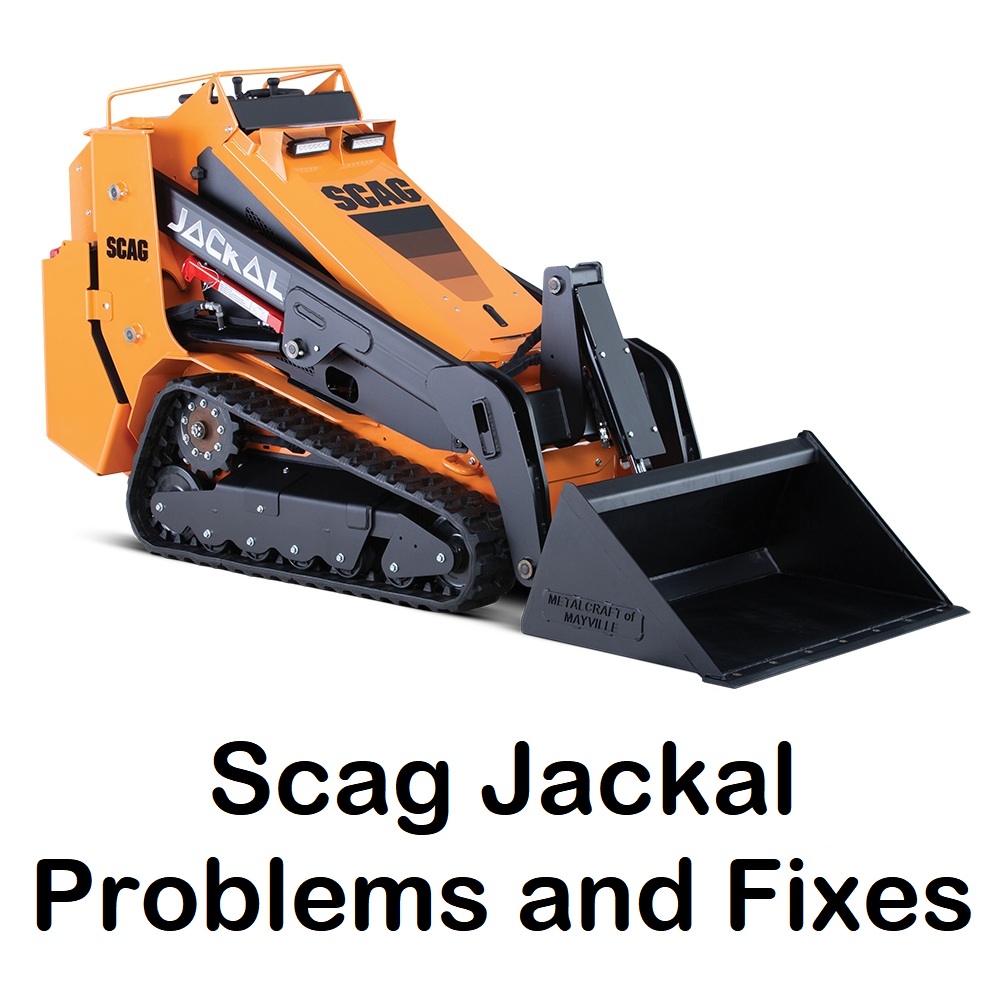
The Scag Jackal is a commercial-grade stand-on mower built to dominate tough terrain with speed and precision. Known for its compact footprint, nimble handling, and powerful Vanguard EFI engines, the Jackal is often favored by professional landscapers. However, like any complex machine, it has its fair share of issues—many of which are tied to hard daily use, wear-and-tear, and lack of maintenance.
In this guide, we’ll explore the most common Scag Jackal problems, backed by real user experiences and expert mechanical insight, and walk through step-by-step fixes to get your machine back in action quickly.
1. Hard Starting or No Start Issue
Symptoms:
- Engine won’t start or cranks but doesn’t fire.
- Starts after multiple attempts.
- Requires choke even in warm weather.
Common Causes:
- Weak battery or loose terminals.
- Bad starter solenoid or ignition switch.
- Faulty fuel pump or clogged filter.
- Dirty spark plugs or faulty coils.
Fixes:
- Battery Check: Use a multimeter to ensure voltage is above 12.4V. Clean and tighten terminals.
- Fuel System: Replace clogged fuel filters; check lines for air leaks; ensure fuel pump is operational.
- Spark & Ignition: Pull spark plugs, inspect for carbon buildup, and replace if worn. Test coils with a spark tester.
- Starter Circuit: Test ignition switch, starter solenoid, and safety interlock switches (PTO, neutral, operator presence).
Pro Tip: If the Jackal sat unused for a while, drain old fuel and use a fuel system cleaner to prevent varnish buildup in the carburetor or injectors.
2. Hydraulic Drive Problems (No Movement or Jerky Operation)
Symptoms:
- One or both wheels do not move.
- Jerky or slow drive.
- Grinding noise or power loss on hills.
Common Causes:
- Air in hydraulic system after fluid change.
- Low or contaminated hydraulic fluid.
- Loose or broken drive belt.
- Faulty pump or wheel motor.
Fixes:
- Bleed the System: Raise rear tires off the ground, start the mower, and cycle the controls to purge air.
- Check Fluid Levels: Use Scag-recommended hydraulic oil; top off or replace if dirty.
- Inspect Belts & Tensioners: Replace frayed or stretched drive belts. Adjust tensioner springs.
- Pump/Wheel Motor Diagnosis: If issues persist, test hydraulic pressure and inspect pump internals.
Overheating hydro systems can cause sudden performance loss. Ensure cooling fans are working and vents are clean.
3. Engine Stalling During Operation
Symptoms:
- Engine dies under load or after warm-up.
- Mower sputters, then shuts off.
- Stalls when engaging PTO or moving fast.
Common Causes:
- Overheating due to dirty fins or low oil.
- Faulty ignition module or failing coil.
- Fuel cap vent clogged (creating a vacuum).
- Safety switches triggering unexpectedly.
Fixes:
- Cooling Maintenance: Clean debris from cylinder fins and engine shrouds. Check engine oil level and viscosity.
- Electrical: Replace faulty coils or ignition modules. Inspect kill wire and connections.
- Fuel Cap: Replace or clean cap vent to allow proper airflow into tank.
- Safety Interlocks: Test seat, PTO, and brake switches. Secure any loose wiring causing false triggers.
Note: Vanguard EFI engines are sensitive to grounding issues—ensure proper ground continuity between engine, frame, and battery.
4. Blade Engagement Issues (PTO Won’t Engage)
Symptoms:
- PTO switch doesn’t activate blades.
- Blades spin slowly or shut off randomly.
- Loud squealing from the deck area.
Common Causes:
- Weak battery or charging system.
- Failed PTO clutch coil or worn clutch.
- Loose or damaged PTO wiring.
- Slipping deck belt.
Fixes:
- Battery & Charging: Ensure battery maintains 12.5V+ under load. Replace weak alternator or voltage regulator if needed.
- PTO Coil Resistance: Check resistance (2–4 ohms). If outside range, replace clutch.
- Belt & Pulley: Replace stretched or frayed deck belts. Realign pulleys and check idler tension.
- Switch & Wiring: Test PTO switch and replace if contacts are corroded. Repair or secure frayed wires.
Never ignore intermittent blade engagement—it can damage the clutch and cause uneven cuts.
5. Uneven Cutting or Deck Scalping
Symptoms:
- Grass is cut unevenly or with visible streaks.
- Deck scalps high spots on lawns.
- Unusual vibrations during cutting.
Common Causes:
- Unleveled deck or worn blades.
- Incorrect deck pitch or height setting.
- Damaged anti-scalp wheels or brackets.
Fixes:
- Deck Leveling: Adjust deck side-to-side and front-to-back (front should be 1/8” lower).
- Blade Inspection: Replace dull, bent, or unbalanced blades.
- Anti-Scalp Wheels: Replace broken or missing wheels. Adjust to proper height.
- Deck Cleaning: Remove grass buildup from under the deck, which can throw off balance.
Use high-lift blades for clean discharges or mulching blades for finer clippings in dry grass.
6. Excessive Vibration
Symptoms:
- Shaking felt through footplate and controls.
- Vibrations worsen with blade engagement.
- Rattling sounds under the deck.
Common Causes:
- Bent blades or spindles.
- Unbalanced blade sets.
- Loose bolts or broken welds on frame or deck.
- Worn bearings in pulleys or spindles.
Fixes:
- Blade Balance: Always replace blades in matched sets and verify balance.
- Spindle Bearings: Spin spindles by hand and listen for grinding; replace if noisy or loose.
- Tighten Hardware: Periodically tighten deck bolts, caster mountings, and engine mounts.
- Inspect Welds: Cracked welds near the platform can cause vibration—reinforce or re-weld if needed.
7. Electrical Issues (Dead Panel, Intermittent Shutdown)
Symptoms:
- No response from dash or control panel.
- Mower shuts off without warning.
- Blown fuses or dead PTO.
Common Causes:
- Loose grounds or corroded connectors.
- Faulty ignition switch.
- Pinched wires under foot platform.
- Moisture or debris in harness plugs.
Fixes:
- Ground Check: Clean and secure engine-to-frame and battery grounds.
- Harness Inspection: Look for pinched or melted wires—especially near moving parts.
- Switch Testing: Test ignition, PTO, and neutral switches using a multimeter.
- Sealed Connectors: Use dielectric grease to seal plugs from water and dust intrusion.
Moisture buildup under the standing platform is a known issue—drill drain holes if water tends to collect.
8. Fuel System Issues (Surging or Fuel Starvation)
Symptoms:
- Engine surges up and down.
- Runs only with choke engaged.
- Fuel smell or leaks under machine.
Common Causes:
- Air leaks in fuel line or fittings.
- Dirty fuel injectors (EFI) or jets (carb).
- Clogged fuel filter or debris in tank.
Fixes:
- Inspect Fuel Lines: Replace cracked or loose lines. Check clamps and fittings.
- Clean Injectors/Jets: Use EFI cleaner or remove carburetor and clean jets with compressed air.
- Replace Filter: Install a new inline fuel filter every 100 hours or as needed.
- Check Venting: Ensure fuel cap vent is working properly to prevent vapor lock.
9. Parking Brake or Control Levers Not Working Properly
Symptoms:
- Mower won’t start due to safety lockout.
- Levers feel too stiff or too loose.
- Parking brake fails to engage fully.
Common Causes:
- Misadjusted or worn linkage.
- Damaged return springs.
- Stuck safety switch under the brake arm.
Fixes:
- Adjust Levers: Recenter control levers and adjust tension as per the manual.
- Replace Springs: Install new return springs on brake or lap bars if movement is sluggish.
- Switch Test: Bypass or replace faulty brake safety switch to regain starting function.
Scag Jackal Maintenance Tips
| Task | Frequency |
|---|---|
| Change Engine Oil | Every 50 hours |
| Replace Spark Plugs | Every 100 hours |
| Clean Air Filter | Every 25 hours |
| Change Fuel Filter | Every 100 hours |
| Inspect Blades | Every 10–20 hours |
| Grease Wheel Bearings | Every 25 hours |
| Clean Hydraulic Cooling Fans | Weekly or more often |
| Tighten Deck & Frame Bolts | Monthly or as needed |
Final Thoughts: Is the Scag Jackal a Reliable Mower?
Yes, the Scag Jackal is a solid, professional-grade stand-on mower with few major flaws. Most of its problems stem from high-intensity use and deferred maintenance, not design defects. If you follow a regular upkeep schedule, replace wear items proactively, and pay attention to early symptoms, your Jackal can deliver years of dependable performance.
Its compact design, excellent weight distribution, and strong hydro drive make it ideal for tight landscapes, residential lots, and small commercial jobs. Just keep tools and spare filters handy during peak mowing season—and you’ll minimize downtime significantly.

I’m David man behind Lawn Mowerly; I’ve been dealing with lawnmowers and Tractors with my father since I was a kid. I know every make and model and what each one is capable of and love helping people find the perfect equipment for their needs.
